The companies that will survive are those that leverage this window to create lasting value beyond their cryptocurrency holdings.
Author: Saurabh Deshpande
Compiled by: Deep Tide TechFlow
Hello!
Newton is famous for discovering gravity, but in his time, he was more interested in another field: the alchemy of finance, or the pursuit of turning lead into gold. This pursuit even led him to delve into theological studies. Modern finance seems to resonate with his interests—through financial engineering, we are in an era of "turning lead into gold," simply by combining the right elements.
In today’s article, Saurabh elaborates on how companies can achieve a premium on their actual value by adding cryptocurrency to their balance sheets. Taking MicroStrategy as an example, this company has quarterly revenues just above $100 million but holds nearly $10.9 billion worth of Bitcoin. Globally, 80 companies are exploring how to incorporate cryptocurrency into their balance sheets. Traditional financial institutions show great interest in this and are paying a premium for the volatility and potential returns of such stocks.
Saurabh also analyzes the rise of convertible bonds, a financial instrument that has helped create this thriving ecosystem, while discussing the risks involved and those companies attempting to incorporate other cryptocurrencies into their balance sheets.
Let’s get to the point!

A software/business intelligence company with quarterly revenues of only $111 million has a market capitalization of $109 billion. How is this possible? The answer is: it bought Bitcoin with other people's money. The market is currently valuing its Bitcoin holdings at a premium of up to 73%. What kind of "alchemy" is behind this?
MicroStrategy (now known as Strategy) has created a financial mechanism that allows it to borrow money to buy Bitcoin at almost no cost. For example, with its $3 billion convertible bond issued in November 2024, here’s how it works:
The company issued convertible bonds with a 0% coupon, meaning bondholders will not receive regular interest payments. Instead, each $1,000 bond can be converted into 1.4872 shares of Strategy stock, provided the stock price rises to $672.40 or higher before maturity.
When these bonds were issued, Strategy's stock price was $433.80, so the stock price needs to increase by 55% for conversion to be profitable. If the stock price never reaches this level, bondholders will get back $1,000 after five years. However, if Strategy's stock price skyrockets (which usually happens when Bitcoin prices rise), bondholders can convert to stock and capture all the upside.
The cleverness of this mechanism lies in the fact that bondholders are essentially betting on Bitcoin's performance while enjoying downside protection that direct Bitcoin holders do not have. If Bitcoin crashes, they can still get their principal back because bonds take precedence over stocks in bankruptcy liquidation. Meanwhile, Strategy can borrow $3 billion at no cost and immediately use those funds to buy more Bitcoin.
However, the key trigger for this mechanism is: starting December 2026 (just two years after issuance), if Strategy's stock price exceeds $874.12 (130% of the conversion price) for a period, the company can force the early redemption of these bonds. This "redemption clause" means that if Bitcoin drives the stock price high enough, Strategy can compel bondholders to convert to stock or redeem their funds early, allowing for refinancing on better terms.
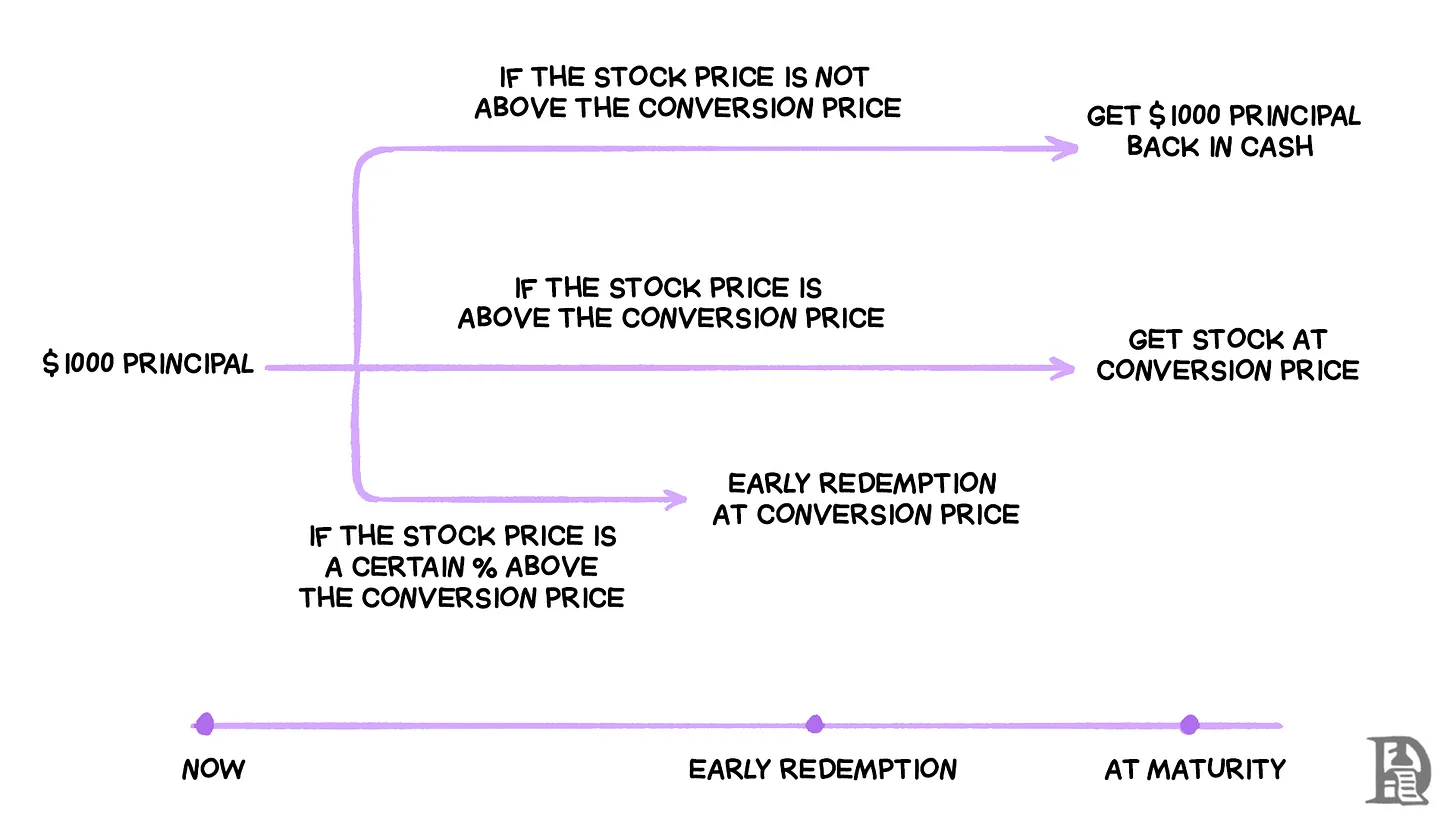
This strategy works because Bitcoin has achieved an average annual growth rate of about 85% over the past 13 years, with an average annual growth rate of 58% over the past 5 years. The company is betting that Bitcoin's growth rate will far exceed the 55% stock price increase required to trigger bond conversion. They have proven the success of this strategy by successfully redeeming early issued bonds, saving millions in interest expenses.
At the core of this structure are three different series of perpetual preferred stock: STRF, STRK, and STRD, each tailored to different types of investors.
STRF: Perpetual preferred stock that offers a 10% cumulative dividend and has the highest priority. If Strategy fails to pay dividends, the company must pay all unpaid STRF dividends before paying any dividends to other shareholders. Additionally, as a penalty, the dividend rate will increase.
STRK: Perpetual preferred stock that offers an 8% cumulative dividend, with medium priority. Unpaid dividends accumulate and must be fully paid before any earnings are distributed to common stock shareholders. Additionally, STRK includes the right to convert to common stock.
STRD: Perpetual preferred stock that offers a 10% non-cumulative dividend, with the lowest priority. The higher dividend rate compensates for the higher risk—if Strategy skips a payment, these dividends will be lost forever, with no obligation to compensate.
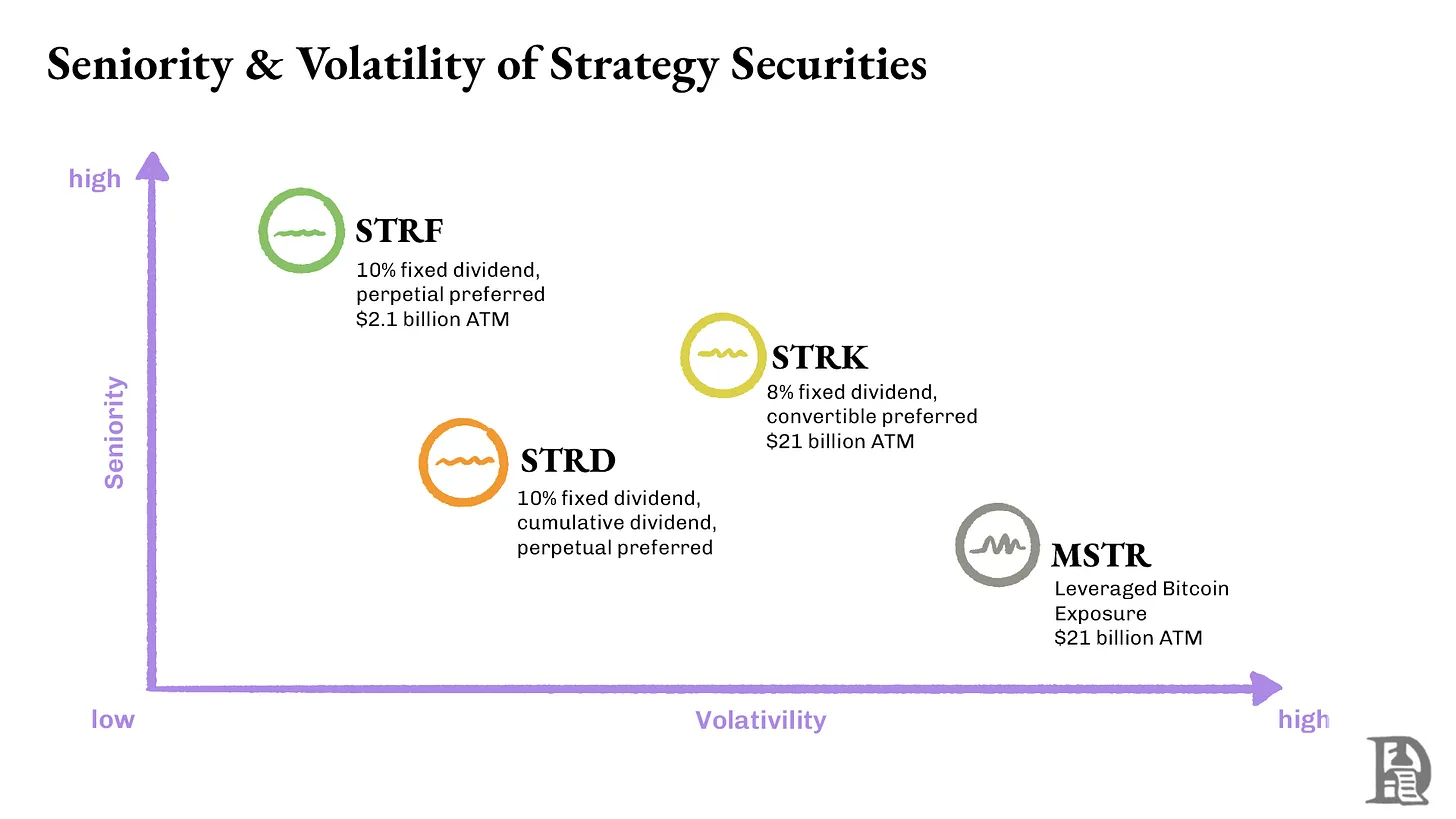
Perpetual preferred stock allows Strategy to raise equity-like capital while paying perpetual dividends similar to bonds. Each series is custom-designed based on investors' risk preferences. The cumulative dividend feature protects holders of STRF and STRK, ensuring they eventually receive all unpaid dividends, while STRD offers higher current yields without a safeguard mechanism for unpaid dividends.
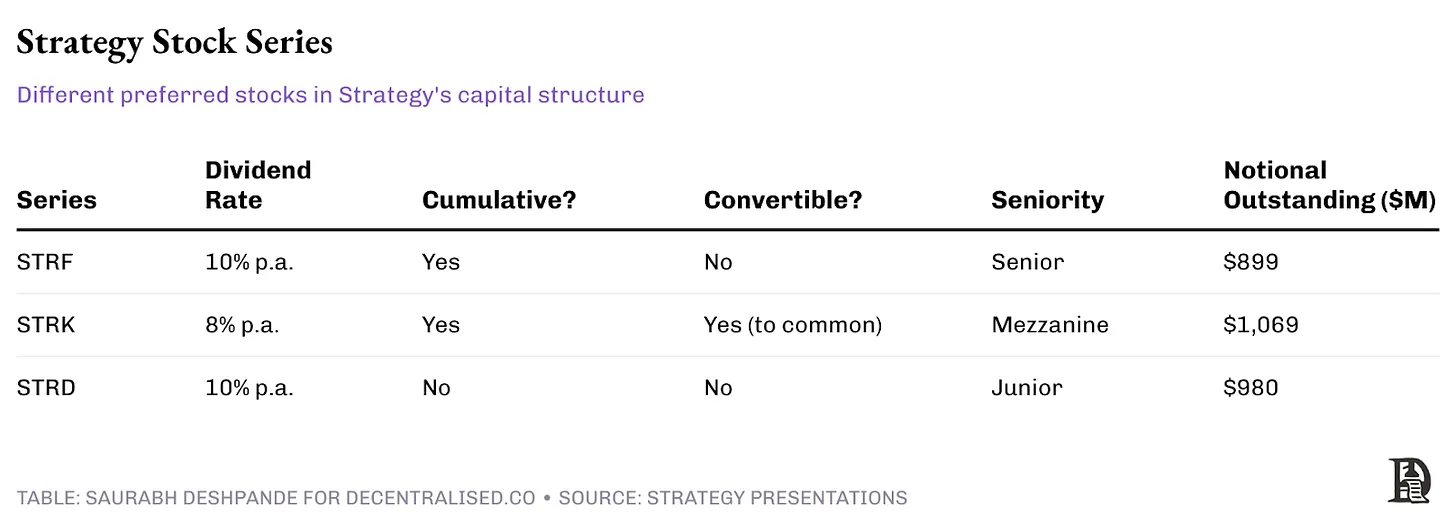
Strategy's Report Card
MicroStrategy began raising funds to purchase Bitcoin in August 2020. Since then, the price of Bitcoin has soared from $11,500 to $108,000, an increase of about 9 times. Meanwhile, MicroStrategy's stock price has risen from $13 to $370, nearly a 30-fold increase.
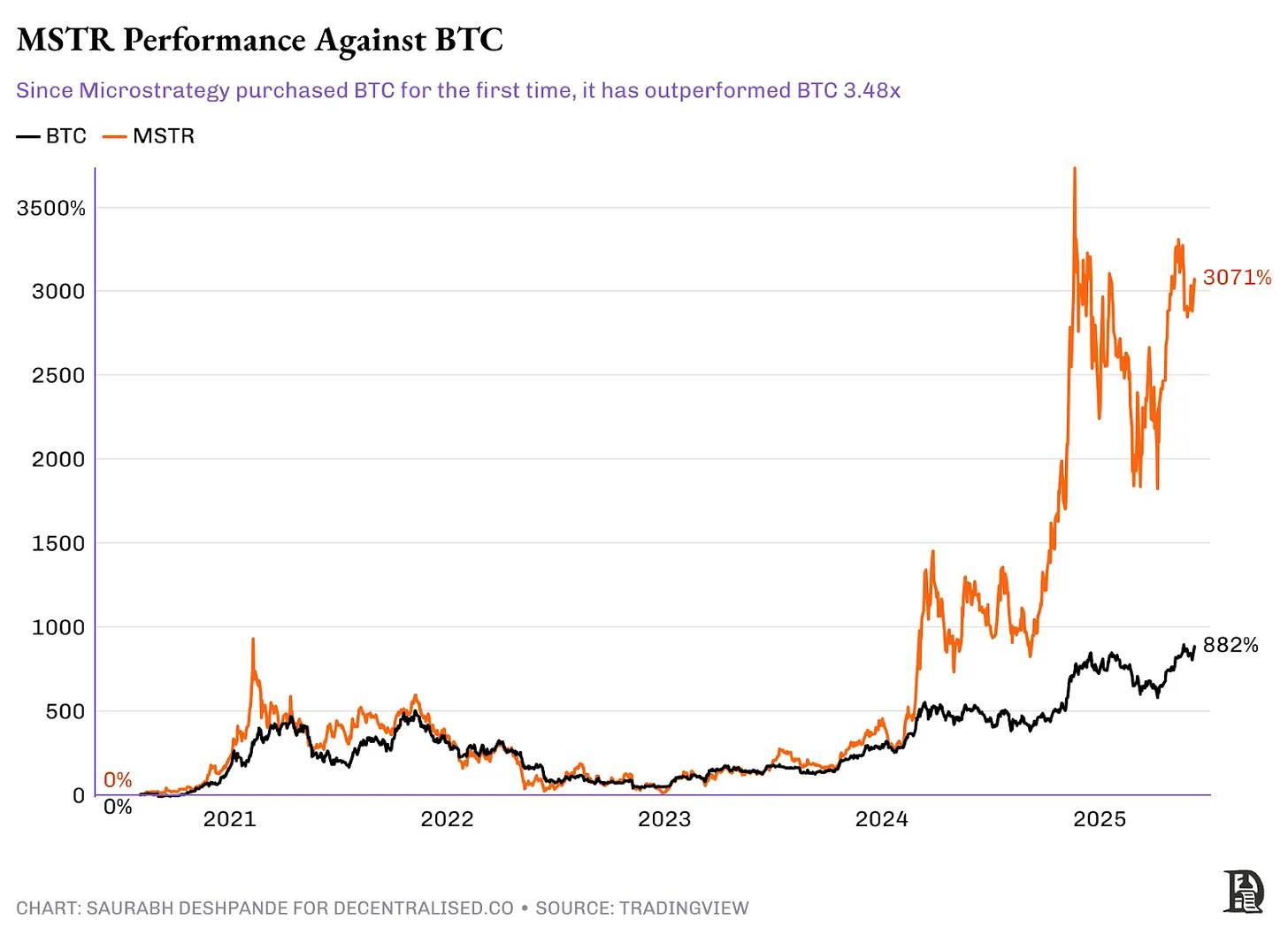
Notably, MicroStrategy's core business has not seen any growth. Their quarterly revenue remains between $100 million and $135 million, consistent with the past. The only change is that they borrowed money to buy Bitcoin. Currently, they hold 582,000 Bitcoins, worth about $63 billion. Their stock market capitalization is approximately $109 billion, which is 73% higher than the actual value of their Bitcoin holdings. Investors are willing to pay an additional premium just to indirectly hold Bitcoin through MicroStrategy's stock.
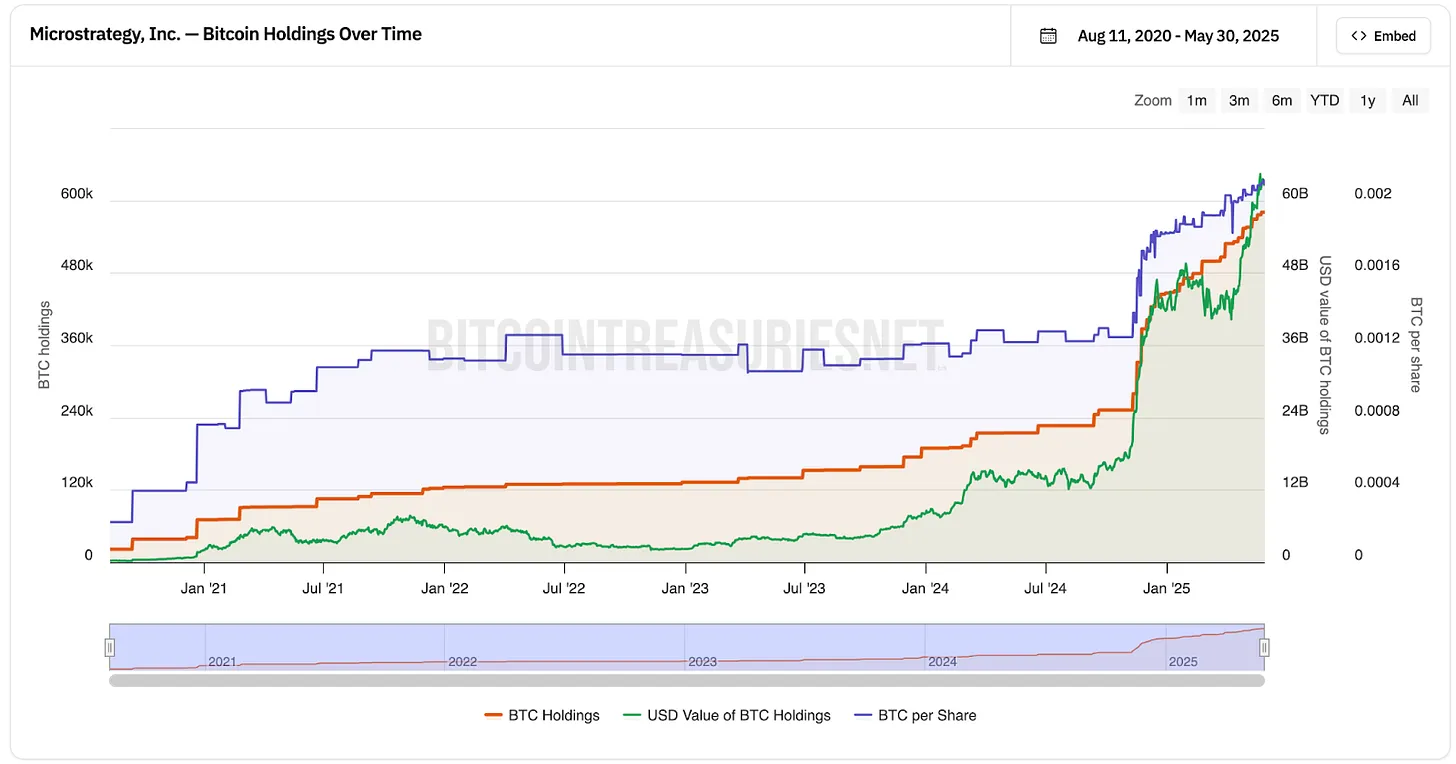
Source: bitcointreasuries.net
As previously mentioned, MicroStrategy funded its Bitcoin purchases by issuing new shares. Since they began buying Bitcoin, the number of company shares has nearly tripled, from 95.8 million shares to 279.5 million shares, an increase of 191%.
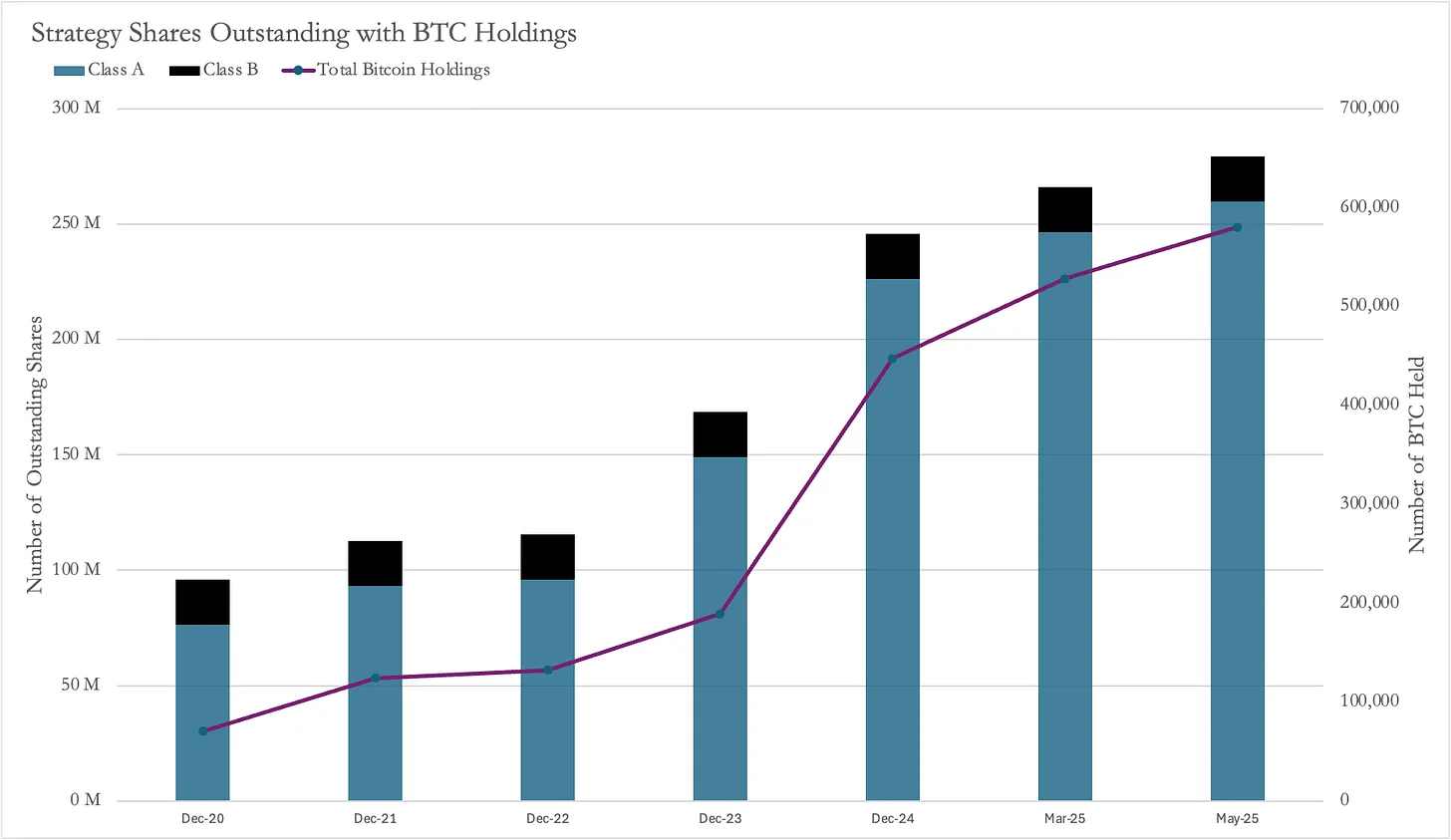
Source: MicroStrategy filings
Typically, issuing such a large number of new shares would dilute existing shareholders, as everyone’s stake in the company would be reduced. However, despite the number of shares increasing by 191%, the stock price has skyrocketed by 2,900%. This means that although shareholders own a smaller percentage of the company, the value per share has significantly increased, and overall, they are still profiting.
MicroStrategy's Successful Model Gains Popularity
Many companies are beginning to emulate MicroStrategy's successful model by holding Bitcoin as a corporate asset. One recent case is Twenty One (XXI). This is a special purpose acquisition company (SPAC) led by Jack Mallers, backed by Cantor Fitzgerald (the son of the U.S. Secretary of Commerce, Brandon Lutnick), Tether, and SoftBank. Unlike MicroStrategy, Twenty One is not publicly traded. The only way to participate in the public market is through Cantor Equity Partners (CEP), which exchanged $100 million for a 2.7% stake in XXI.
Twenty One holds 37,230 Bitcoins. Since CEP owns 2.7% of Twenty One, this effectively means CEP controls about 1,005 Bitcoins (valued at approximately $108,000 each, worth about $108.5 million).
However, the market capitalization of CEP's stock is as high as $486 million, which is 4.8 times its actual Bitcoin value! After the announcement of its Bitcoin association, CEP's stock price soared from $10 to about $60.
This enormous premium means that investors paid $433 million for a $92 million Bitcoin exposure. As more similar companies emerge and increase their Bitcoin holdings, market forces will eventually bring these premiums back to a more reasonable level, although no one knows when this will happen or what the "reasonable level" actually is.
An obvious question is: why do these companies have a premium? Why are investors willing to pay a premium to buy shares of these companies instead of directly purchasing Bitcoin from the market to gain exposure? The answer may lie in "optionality." Who is funding MicroStrategy's Bitcoin purchases? Primarily hedge funds seeking "risk-free arbitrage" (delta-neutral strategies) through trading bonds.
Upon closer examination, this trade is very similar to Grayscale's Bitcoin Trust (GBTC). In the past, Grayscale's Bitcoin Trust also traded at a premium above Bitcoin because it was closed-end (investors could not withdraw Bitcoin until it was converted to an ETF).
Thus, investors would deposit Bitcoin into Grayscale and sell their publicly traded GBTC shares. As previously mentioned, MicroStrategy's bondholders can enjoy an average annual compound growth rate (CAGR) of over 9%.
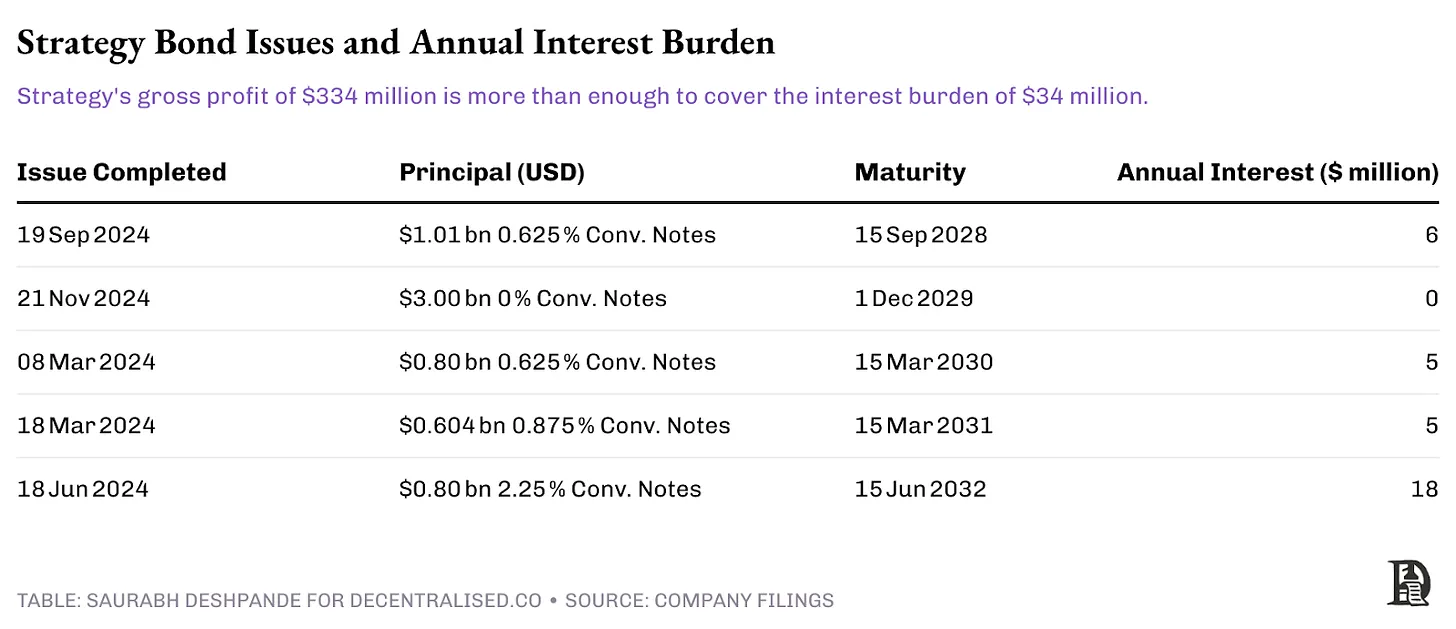
But how significant is this risk? MicroStrategy's annual interest burden totals $34 million, while its gross profit for the fiscal year 2024 is $334 million, sufficient to cover the debt. MicroStrategy issued convertible bonds linked to Bitcoin's four-year cycle, with a maturity long enough to mitigate the risk of price declines. Therefore, as long as Bitcoin rises more than 30% within four years, the new stock issuance can easily cover the redemption costs.
When redeeming these convertible bonds, MicroStrategy can simply issue new shares to bondholders. Bondholders will be paid based on the reference stock price at issuance, which is approximately 30-50% higher than the stock price at the time of bond issuance. This only becomes an issue if the stock price falls below the conversion price. In this case, MicroStrategy must return cash, which can be repaid by raising a new round of debt on better terms or by selling Bitcoin to raise cash.
Value Chain
This process clearly begins with the company trying to acquire Bitcoin, but ultimately they utilize exchanges and custody services. For example, MicroStrategy is a client of Coinbase Prime, purchasing Bitcoin through Coinbase and storing it in Coinbase Custody, Fidelity, and its own multi-signature wallets. While it is difficult to accurately estimate how much Coinbase has earned from MicroStrategy's Bitcoin execution and storage, we can make some guesses.
Assuming exchanges like Coinbase charge a fee of 5 basis points for executing over-the-counter trades representing MicroStrategy's Bitcoin purchases, buying 500,000 Bitcoins at an average execution price of $70,000, they would earn $17.5 million from execution. Bitcoin custodians charge an annual fee ranging from 0.2% to 1%. Assuming the lower end of the range, storing 100,000 Bitcoins at $108,000 would earn the custodian $21.6 million annually for storing Bitcoin for MicroStrategy.
Beyond BTC
So far, financial instruments designed to provide exposure to Bitcoin (BTC) in capital markets have performed well. In May 2025, SharpLink raised $425 million through a PIPE financing led by ConsenSys founder Joe Lubin, who also became the company's executive chairman. This financing issued approximately 69 million new shares at a price of $6.15 per share, with funds intended to purchase about 120,000 Ethereum (ETH) and potentially participate in staking thereafter. Currently, ETH exchange-traded funds (ETFs) do not allow staking.
This financial instrument offering a 3%-5% yield is more attractive than ETFs. Before this announcement, SharpLink's stock price was $3.99, with a total market capitalization of about $2.8 million and only 699,000 shares outstanding. The issuance price of this financing was at a 54% premium to the market price. After the announcement, its stock price soared to $124.
Notably, the newly issued 69 million shares are equivalent to about 100 times the current number of outstanding shares.
Another company, Upexi, plans to acquire over 1 million Solana (SOL) tokens before the fourth quarter of 2025 while maintaining cash flow neutrality. This plan began with a private financing round led by GSR, where Upexi raised $100 million by selling 43.8 million shares. Upexi expects to pay preferred stock dividends through 6%-8% staking yields and maximum extractable value (MEV) returns, providing self-funding for future SOL purchases. On the day of the announcement, its stock price surged from $2.28 to $22, then closed at about $10.
Before the financing, Upexi had 37.2 million shares outstanding, so the newly issued shares caused about 54% dilution for existing shareholders, but the stock price skyrocketing nearly 400% was enough to offset the dilution losses.
Sol Strategies is another company financing the purchase of SOL through capital markets. The company operates Solana validation nodes, with over 90% of its revenue coming from staking rewards. Currently, the company has staked 390,000 SOL, with about 3.16 million SOL delegated to its nodes by third parties. In April 2025, Sol Strategies reached a convertible bond agreement with ATW Partners, securing a financing limit of up to $500 million, with the first $20 million already used to purchase 122,524 SOL.
Recently, Sol Strategies submitted a shelf registration statement, planning to refinance $1 billion through common stock (including "at-the-market offerings"), warrants, subscription receipts, units, debt securities, or any combination thereof. This provides the company with diversified financing flexibility.
Unlike MicroStrategy's convertible bond model, SharpLink and Upexi are financing through direct issuance of new shares. Personally, I believe MicroStrategy's model is better suited for a different target investor group. Compared to directly purchasing ETH or SOL, investors gaining exposure through stock purchases indirectly must bear additional risks, such as intermediaries potentially leveraging beyond the investors' risk tolerance. Therefore, unless there is additional service value added, the model of using convertible bonds with sufficient operating profit buffers to pay interest is more reasonable.
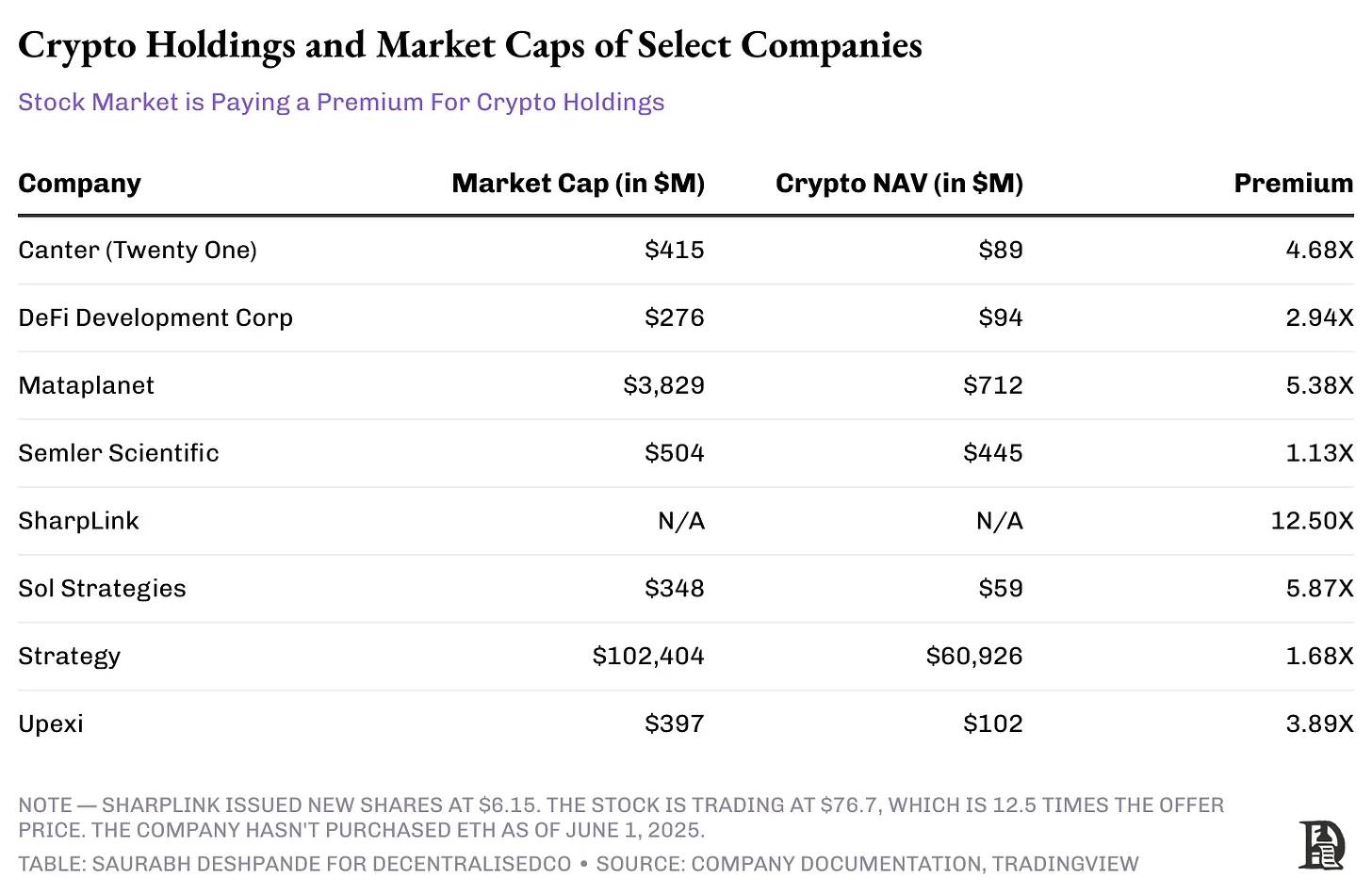
When the Music Stops
These convertible bonds are primarily aimed at hedge funds and institutional bond traders seeking asymmetric risk-return opportunities, rather than retail investors or traditional equity funds.
From their perspective, these financial instruments offer the option of "big wins and limited losses," fitting well within their risk management framework. If Bitcoin achieves the expected 30%-50% increase within two to three years, they can choose to convert the bonds; if the market performs poorly, they can still recover 100% of their principal, although they may lose some value due to inflation.
The advantage of this structure is that it addresses the practical issues faced by institutional investors. Many hedge funds and pension funds lack the infrastructure to directly hold cryptocurrencies or cannot directly purchase Bitcoin due to investment restrictions. These convertible bonds provide them with a compliant "backdoor" into the crypto market while maintaining the downside protection required for fixed-income assets.
However, this advantage is destined to be temporary. As regulations become clearer and more direct crypto investment tools (such as custody solutions, regulated exchanges, and clearer accounting standards) emerge, the demand for these complex workarounds will gradually decrease. The 73% premium that investors currently pay to gain Bitcoin exposure through MicroStrategy may shrink with the emergence of more direct alternatives.
We have seen similar situations before. In the past, opportunistic managers exploited the premium of Grayscale Bitcoin Trust (GBTC)—buying Bitcoin and depositing it into Grayscale's trust, then selling GBTC shares in the secondary market at a premium of 20%-50% above net asset value (NAV). However, as more people began to follow suit, by the end of 2022, GBTC's premium turned into a record 50% discount. This cycle indicates that without sustainable income to support repeated financing, stock plays backed by cryptocurrencies will ultimately be arbitraged away by the market.
The key question is, how long can this situation last, and who will stand firm when the premium collapses? Companies with strong business fundamentals and conservative leverage may withstand this transition, while those lacking sustainable income sources or competitive moats, merely chasing cryptocurrency assets, may face sell-offs due to dilution when the speculative frenzy subsides.
Currently, the music is still playing, and everyone is dancing. Institutional capital is flooding in, premiums are expanding, and more companies are announcing Bitcoin and cryptocurrency asset strategies every week. However, savvy investors know this is a trade, not a long-term investment logic. The companies that will survive are those that leverage this window to create lasting value beyond their cryptocurrency holdings.
The transformation of corporate financial management may be permanent, but the extraordinary premiums we see today are not. The question is, are you ready to profit from this trend, or are you just another player hoping to find a seat when the music stops?
免责声明:本文章仅代表作者个人观点,不代表本平台的立场和观点。本文章仅供信息分享,不构成对任何人的任何投资建议。用户与作者之间的任何争议,与本平台无关。如网页中刊载的文章或图片涉及侵权,请提供相关的权利证明和身份证明发送邮件到support@aicoin.com,本平台相关工作人员将会进行核查。




